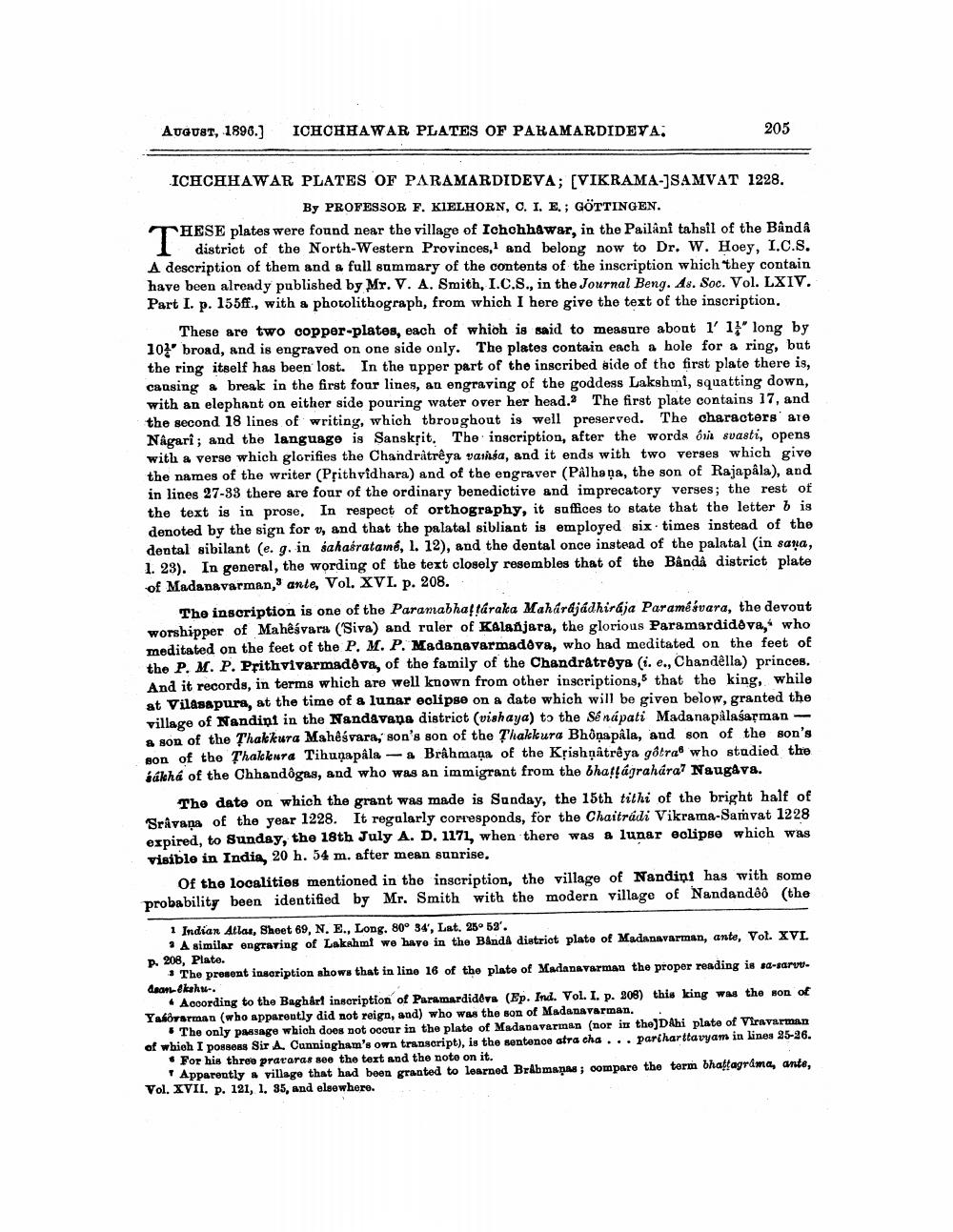________________
AUGUST, 1896.)
ICHCHHAWAR PLATES OF PARAMARDIDEVA,
205
ICHCHHAWAR PLATES OF PARAMARDIDEVA; [VIKRAMA-JSAMVAT 1228.
By PROFESSOR F. KIELHORN, C. I. E.; GÖTTINGEN. THESE plates were found near the village of Ichchhawar, in the Pailäni tahsil of the Banda
1 district of the North-Western Provinces, and belong now to Dr. W. Hoey, I.C.S. A description of them and a full summary of the contents of the inscription which they contain have been already published by Mr. V. A. Smith, I.C.S., in the Journal Beng. As. Soc. Vol. LXIV. Part I. p. 155ff., with a photolithograph, from which I here give the text of the inscription,
These are two copper-plates, each of which is said to measure about 1' 1' long by 101 broad, and is engraved on one side only. The plates contain each a hole for a ring, but the ring itself has been lost. In the upper part of the inscribed side of the first plate there is, causing a break in the first four lines, an engraving of the goddess Lakshmi, squatting down, with an elephant on either side pouring water over her head. The first plate contains 17, and the second 18 lines of writing, which tbroughout is well preserved. The characters are Nagari; and the language is Sanskrit. The inscription, after the words or svasti, opens with a verse which glorifies the Chandråtrêya ramsa, and it ends with two verses which give the names of the writer (Prithvidhara) and of the engraver (Palhaņa, the son of Rajapala), and in lines 27-33 there are four of the ordinary benedictive and imprecatory verses; the rest of the text is in prose. In respect of orthography, it soffices to state that the letter b is denoted by the sign for y, and that the palatal sibliant is employed six times instead of the dental sibilant (e. g. in sahasratamé, 1. 12), and the dental once instead of the palatal (in sana, 1. 23). In general, the wording of the text closely resembles that of the Banda district plate of Madanavarman, ante, Vol. XVI. p. 208..
The inscription is one of the Paramabhaftáraka Maharajadhiraja Paramé svara, the devont worshipper of Maheśvara ('Siva) and ruler of Kalanjara, the glorious Paramardidėva, who meditated on the feet of the P. M. P. Madanavarmadáva, who had meditated on the feet of the P. M. P. Prithvivarmadáva, of the family of the Chandratroys (i. e., Chandella) princes. And it records, in terms which are well known from other inscriptions, that the king, while at Vilasapura, at the time of & lunar eclipse on a date which will be given below, granted the village of Nandini in the Nandavana district (vishaya) to the Sé nápati MadanapalasaȚman - & son of the Thakkura Mahêśvara,' son's son of the ? 'hakkura Bhôņapâla, and son of the son's son of the Thakknta Tihunapala - a Brâhmaņa of the Krishạâtrêya gôtra who studied the bákhá of the Chhandôgas, and who was an immigrant from the bhaflágrahára? Naugava.
The date on which the grant was made is Sunday, the 15th tithi of the bright half of Sråvana of the year 1228. It regalarly corresponds, for the Chaitrádi Vikrama-Samvat 1228 expired, to Sunday, the 18th July A. D. 1171, when there was a lunar eclipse which was visible in India, 20 h. 54 m. after mean sunrise.
Of the localities mentioned in the inscription, the village of Nandini has with some probability been identified by Mr. Smith with the modern village of Nandandoo (the
1 Indian Atlas, Sheet 69, N. E., Long. 80° 34', Lat. 25° 59'.
? A similar engraving of Lakahmt we have in the Bandi district plate of Madanavarman, ante, Vol. XVI. P. 208, Plate.
The present inscription shows that in line 16 of the plate of Madanavarman the proper reading is sa-sarvu. daan- ekshu-.
• According to the Baghårt inscription of Paramardideva (Ep. Ind. Vol. I. p. 308) this king was the son of Yalvarman (who apparently did not reign, and) who was the son of Madanavarman.
. The only passage which does not occur in the plate of Madagavarman (nor in tho)DAhi plate of Viravarman of which I possess Sir A. Cunningham's own transcript), is the sentence atra cha ... parihartta vyam in lines 25-26.
. For his three prararas see the text and the noto on it.
Apparently village that had been granted to learned Brabmaņas; compare the term bhattagrama, ante, Vol. XVII. p. 121, 1, 85, and elsewhere.




